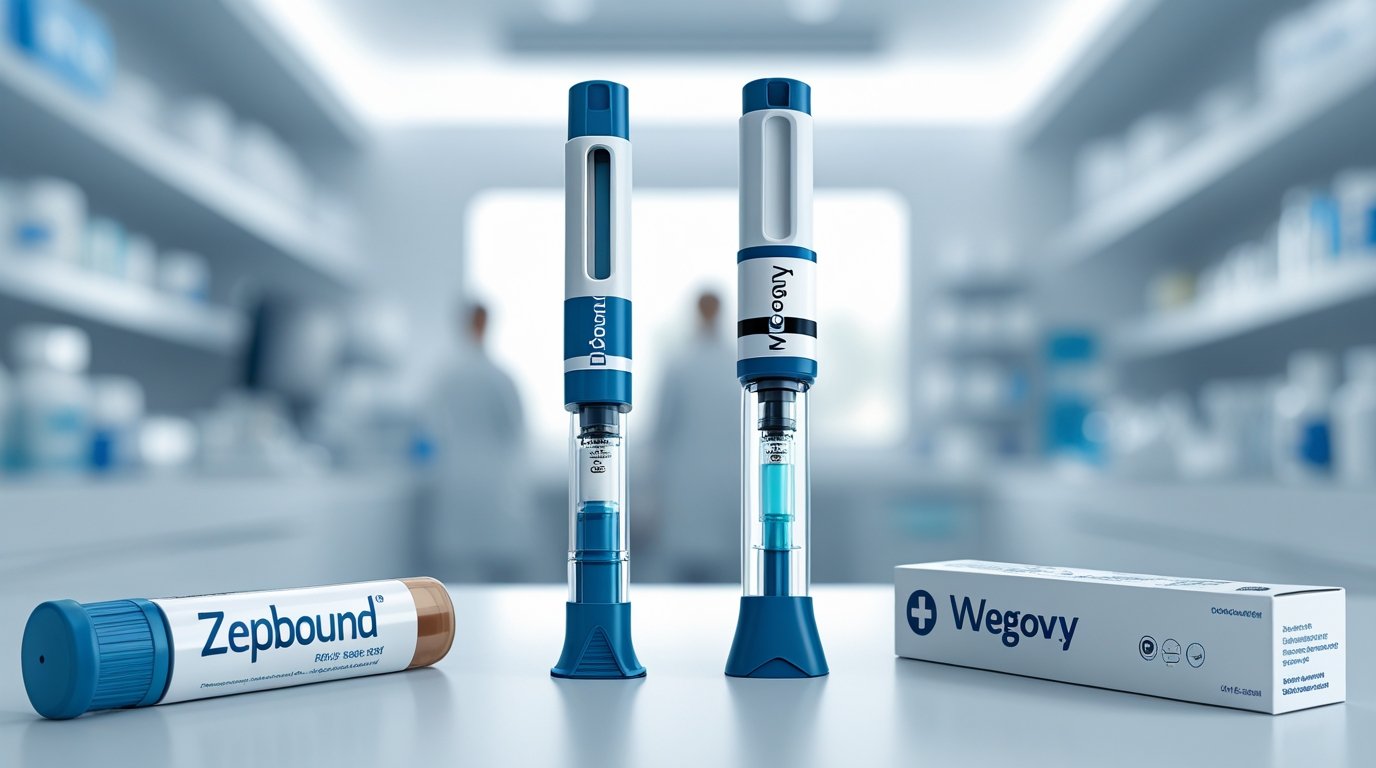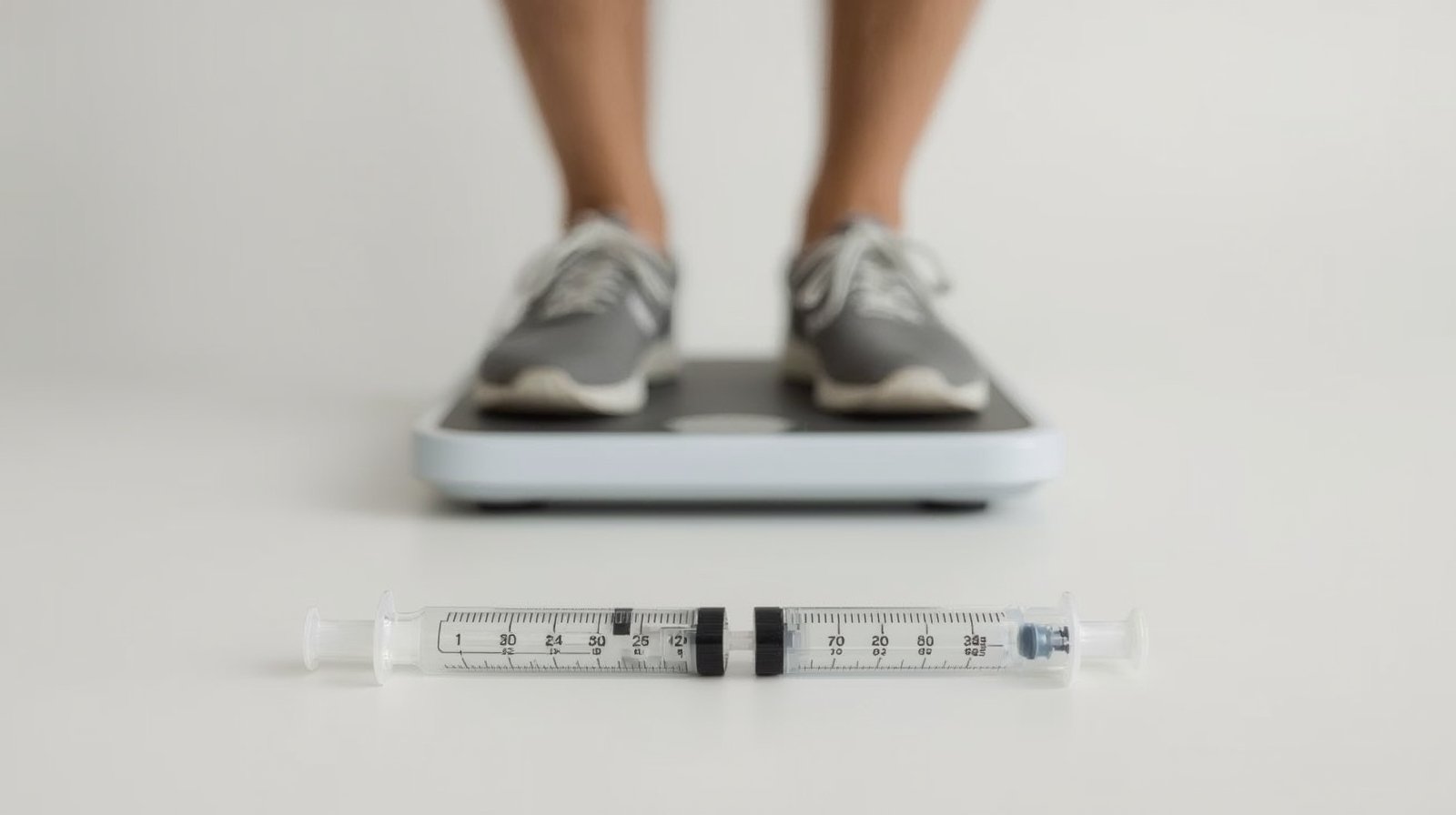
Semaglutide is an injectable medication used to treat type 2 diabetes and obesity. Semaglutide injection is the form of administration, and it is important to use proper injection technique to ensure safety and effectiveness. Semaglutide/cyanocobalamin is a compounded form of semaglutide used to treat overweight and obesity. Cyanocobalamin is a synthetic form of vitamin B12. It is widely used to treat vitamin B12 deficiency. Let’s explore more about the short and long-term side effects of Semaglutide.
Semaglutide is a glucagon-like peptide 1 (GLP-1) receptor agonist, which means it acts just like the GLP-1 hormone produced in your gut.
Semaglutide has the following effects on your body:
- Stimulates your pancreas to release insulin
- Improves insulin sensitivity
- Blocks your liver from releasing glucose into your bloodstream by decreasing glucagon hormone
- Slows stomach-emptying
- Signals your brain that you are full and satisfied
Boosting GLP-1 levels in your body has many important benefits when you are trying to lose weight or control your blood sugar. Semaglutide injections play a significant role in weight management and promoting weight loss, with their effectiveness supported by clinical trials in people with and without diabetes.
However, changing one’s hormonal balance is likely to trigger some unwanted side effects. Many of these side effects are discussed when people post information about their before-and-after results when taking semaglutide.
Because everyone’s metabolism is different, the type, severity, and duration of side effects they experience can vary widely. Adverse events and adverse event reports are closely monitored to ensure patient safety and inform ongoing research.
Weigh the risks and benefits before taking semaglutide, as with any medication. In many cases, semaglutide side effects diminish over time. Learn more about known side effects, what to expect, and tips for managing them.
- Allergic Reactions to Semaglutide/cyanocobalamin
- Constipation
- Diarrhea
- Face Changes
- Fatigue
- Gallbladder disease
- Hair Loss
- Headache
- Indigestion/Heartburn
- Kidney Problems
- Low Blood Sugar
- Nausea and Vomiting
- Pancreatitis
- Rebound Weight Gain
- Thyroid Tumors
- Conclusion to Short and Long-term Side Effects of Semaglutide
- Frequently Asked Questions
- What is the long term side effect of semaglutide?
- What is the dark side of semaglutide?
- Can semaglutide damage your pancreas?
- What are the side effects of semaglutide in the first week?
Introduction to Semaglutide
Semaglutide is a prescription medication designed to help manage type 2 diabetes and support weight loss in adults. As a member of the glucagon-like peptide 1 (GLP-1) receptor agonist class, semaglutide works by mimicking the action of the natural GLP-1 hormone in your body. This action helps lower blood sugar levels by stimulating insulin release, reducing the amount of glucose produced by the liver, and slowing down gastric emptying. These effects not only help control blood sugar but also promote weight loss by increasing feelings of fullness and reducing food intake.
Semaglutide is typically administered as a once-weekly injection, and your healthcare provider will guide you through a dose escalation schedule to minimize side effects such as nausea, vomiting, and diarrhea. It’s important to follow your provider’s instructions closely, especially if you have a personal or family history of medullary thyroid carcinoma or multiple endocrine neoplasia syndrome type 2, as these conditions may increase your risk of certain side effects. Regular monitoring of your blood sugar levels and ongoing communication with your healthcare team are essential to ensure the medication is both safe and effective for your individual needs.
Allergic Reactions to Semaglutide/cyanocobalamin
Severe allergic reactions (allergic reaction) to semaglutide or any of its components (cyanocobalamin) are rare but potentially serious side effects. Serious allergic reactions may include symptoms such as rash, swelling of the face, tongue, or throat, and trouble breathing, which require immediate medical attention. If you experience any of these symptoms, seek medical help and contact your doctor immediately. Call 911 or get immediate help if you have swelling of your face, tongue, or throat or shortness of breath.
Tell your doctor if you notice itching, redness, or rash at your semaglutide/cyanocobalamin injection site (2).
Constipation
Semaglutide/cyanocobalamin slows stomach emptying and the digestive process. Food and waste move more slowly through the gastrointestinal tract. When waste sits in the colon longer, more water is reabsorbed. This can cause stools to become excessively hard and dry, causing constipation. Constipation is one of several gastrointestinal symptoms that may occur with semaglutide use.
Diarrhea
Semaglutide and other GLP-1 agonists slow stomach emptying. Semaglutide changes how fast food and waste move through your gastrointestinal tract. If they move too quickly, water is not reabsorbed from waste in the colon, and you can get diarrhea. Diarrhea is one of the gastrointestinal effects commonly reported with semaglutide.

Face Changes
One common observation people make when taking semaglutide for weight loss is decreased facial fullness. Fat just under the skin, or subcutaneous fat, supports the skin and provides fullness. When you lose weight rapidly, you may notice facial fat loss. Without support from fat, facial skin may sag and wrinkle because it cannot respond as quickly to fat loss.
Slower weight loss may reduce this effect, but that may run counter to your goal of taking these medications. If you are concerned about changes in your facial appearance, talk to your doctor. They may suggest treatments to restore subcutaneous fat in certain areas of the face (4).
Fatigue
It is not clear exactly why semaglutide causes fatigue, but some potential explanations include its effect on appetite and energy intake or a response to side effects. Fatigue may result from decreased calorie intake (5, 6).
If you have stressful side effects, such as nausea and diarrhea, this can increase cortisol levels, which can contribute to fatigue. It is important to ensure you are staying well-hydrated and maintaining a healthy electrolyte balance if you have vomiting or diarrhea.
Gallbladder disease
The gallbladder is a sac-like structure under the liver that concentrates and stores bile. Symptoms of gallbladder disease due to inflammation or gallstones include pain in the upper right quadrant of your abdomen, fever, a yellowish tinge to the skin and eyes (jaundice), and clay-colored stools. Gallbladder problems, such as cholelithiasis and cholecystitis, have been reported in patients taking semaglutide.
Gallbladder disease is not common when taking semaglutide, but if it occurs, contact your doctor right away for treatment. Rapid weight loss, changes in hormone secretion in the gut, and reduced gallbladder emptying are all potential links between semaglutide and gallbladder disease (7).

Hair Loss
Losing weight quickly can be a physical stressor on your body, resulting in hair shedding, a condition called telogen effluvium. This condition causes more hair follicles to enter the resting phase, leading to increased hair shedding.
Nutritional deficiencies can also cause hair loss. Check with your doctor to see if you need any nutritional supplements while taking semaglutide/cyanocobalamin.
Headache
Changes in blood sugar levels, dehydration, hormonal changes, or how semaglutide acts on the hypothalamus, a part of the brain that controls appetite, are all potential triggers for headaches when taking semaglutide/cyanocobalamin. However, it is unclear whether headaches and semaglutide use are directly related.
Is a GLP-1 Medication Right for You?
See if a GLP-1 like Semaglutide or Tirzepatide is a fit for your health goals.
Indigestion/Heartburn
Since semaglutide/cyanocobalamin slows your stomach’s emptying, it can cause indigestion because food sits in your stomach longer. You may also notice bloating, fullness, and abdominal discomfort. These symptoms can worsen if you eat large or high-fat meals (9). Indigestion and heartburn are considered adverse reactions to semaglutide and should be monitored to ensure patient safety.
Heartburn is a symptom of indigestion and is a burning sensation in the middle of your chest. Heartburn is more likely to occur right after eating, especially when lying down or bending over.
Chew your food thoroughly and consume more frequent, smaller meals to reduce your risk of indigestion and heartburn. Stay upright for 30 minutes or more to prevent food from refluxing from your stomach into the esophagus. Avoid foods known to trigger indigestion and heartburn, such as caffeine, alcohol, fried or spicy foods, onions, garlic, chocolate, and peppermint.
Kidney Problems
In rare cases, semaglutide/cyanocobalamin is associated with acute kidney injury. This may be due to rapid weight loss, dehydration, or the worsening of a pre-existing kidney condition (10). Semaglutide is also being studied in patients with chronic kidney disease to assess its potential to slow disease progression, and proper management is important to help prevent kidney failure.
Tell your doctor about all previously diagnosed medical conditions you may have, as well as all medications you are taking. If you have vomiting or diarrhea and are unable to stay hydrated, contact your doctor, especially if you have concentrated urine, are urinating infrequently, notice decreased urination, or notice swelling of your hands and feet.

Low Blood Sugar
Semaglutide increases insulin release from the pancreas in response to a meal. Insulin lowers your blood sugar and can cause hypoglycemia, but it is not common with semaglutide because its effects are limited to releasing insulin only after a meal (9).
Hypoglycemia is more common if you combine semaglutide with another blood-sugar-lowering medication such as insulin or sulfonylureas. Tell your doctor if you take other medications to lower your blood sugar, as you may need a dosage change when you start semaglutide.
Nausea and Vomiting
Nausea and vomiting are some of the more common semaglutide/cyanocobalamin side effects. Semaglutide slows stomach emptying, so food stays in the stomach longer. This can help you feel full longer, but it can also trigger nausea and vomiting. These symptoms are among the most frequently reported adverse events in clinical studies of semaglutide.
All the GLP-1 diabetes and anti-obesity medications cause nausea and vomiting. The symptoms are worse when you first start treatment and when your medication dose is increased (8, 11). Symptoms usually develop within the first week to months after starting semaglutide and then gradually improve (1). The dosage of semaglutide should be slowly increased to reduce the risk of nausea. If your nausea persists or worsens, contact your healthcare provider to see if a dosage increase should be delayed or if you should decrease your medication dose.
Most gastrointestinal side effects are described as mild-to-moderate in intensity. Researchers found women are more likely to have nausea and vomiting from semaglutide, but stomach-related severe side effects are equally common in men and women. Increasing age is also associated with increased nausea and vomiting when taking semaglutide. Overall, increasing age and body weight were most strongly correlated with increased nausea and vomiting with semaglutide (1).
To help minimize nausea and vomiting when taking semaglutide:
- Eat smaller meals
- Eat slowly and chew your food thoroughly
- Avoid high-fat foods
- Stay hydrated
- Avoid irritating foods, such as spicy or greasy foods
- Avoid ultra-processed foods and alcohol
- Stay upright after eating to reduce heartburn
- Sip ginger or peppermint tea
Pancreatitis
Pancreatitis, or inflammation of the pancreas, is a rare side effect when taking semaglutide. While rare, pancreatitis is serious and can even be life-threatening. Acute pancreatitis has been reported in some patients taking semaglutide, making it important to recognize and manage this severe complication promptly. Symptoms of pancreatitis include severe abdominal pain, nausea, vomiting, and/or jaundice, which is a yellowish tinge to the skin and eyes.
It is unclear how semaglutide increases the risk of pancreatitis. One theory is that semaglutide stimulates increased activity in the pancreas, which could lead to inflammation. Semaglutide/cyanocobalamin and other GLP-1 agonists may increase the production of digestive enzymes in the pancreas, triggering inflammation (12).

Rebound Weight Gain
Obesity is a chronic disease. Semaglutide is intended to be taken long-term to control appetite and support weight loss. Longer-term studies show that as long as semaglutide continues, weight loss will continue. Weight regain is common when the medication is stopped (13).
If you plan to stop taking semaglutide at some point, it is important to establish healthy eating and exercise habits to help maintain your weight loss. Before stopping semaglutide, talk to your healthcare provider to discuss the risks and benefits of stopping this medication.
Thyroid Tumors
Semaglutide has a boxed warning for thyroid tumors. This is the strictest warning that requires drug manufacturers to include on their labels. In animal studies, rodents developed thyroid tumors in response to GLP-1 agonists. This increased risk has not been confirmed in human studies.
Contraindications to taking semaglutide include a personal or family history of medullary thyroid carcinoma (MTC) or multiple endocrine neoplasia (MEN) type 2. Medullary thyroid carcinoma (MTC) is a rare type of thyroid cancer that can be genetically linked to MEN2 syndrome, and patients with a history of MTC should not use semaglutide. If you have a lump in your neck or any pressure when swallowing or breathing, contact your doctor.
The number of effective weight-loss medications has increased over the last decade. If you experience side effects when taking semaglutide, contact your doctor to learn more about other weight-loss options.
Diabetic Complications: Retinopathy and Other Risks
Managing diabetes involves more than just lowering blood sugar—it’s also about preventing long-term complications that can impact your overall health. One such complication is diabetic retinopathy, a condition that can cause blurred vision and even vision loss if not properly managed. If you have a history of diabetic retinopathy, it’s especially important to monitor for any changes in your vision while taking semaglutide, as rapid improvements in blood sugar levels may temporarily worsen this condition.
In addition to eye health, semaglutide may affect other organs. There is a potential risk of developing thyroid tumors, including medullary thyroid carcinoma, particularly in individuals with a personal or family history of this type of cancer or multiple endocrine neoplasia syndrome. Kidney disease and acute kidney injury are also possible, especially if you experience severe nausea, vomiting, or dehydration. Monitoring your kidney function and blood pressure regularly with your healthcare provider can help catch any issues early.
Heart disease is another concern for people with diabetes, and while semaglutide has been shown to reduce the risk of major cardiovascular events in some patients, it’s still important to have regular check-ups and discuss your treatment plan with your healthcare provider. If you notice any new symptoms, such as severe stomach pain, trouble swallowing, or changes in urination, seek medical attention promptly. By staying proactive and working closely with your healthcare team, you can minimize the risks and maximize the benefits of semaglutide as part of your diabetes management plan.
Conclusion to Short and Long-term Side Effects of Semaglutide
Understanding the short and long-term side effects of semaglutide can significantly impact your decision to incorporate it into your health regimen. If you’re ready to buy semaglutide and seek professional guidance, Alyn MD provides a reliable pathway to access this medication. It is important to work closely with your health care team to manage side effects, monitor your progress, and optimize treatment outcomes. Their expertise ensures that you receive the support needed to navigate potential side effects and maximize the benefits of semaglutide for your health goals. For more information on how to proceed, visit Alyn MD website.
As low as $197/Mo
Frequently Asked Questions
What is the long term side effect of semaglutide?
The long-term side effects of semaglutide may include gastrointestinal issues such as nausea, vomiting, and diarrhea, as well as potential effects on the pancreas and thyroid gland. These are among the adverse events reported in long-term studies of semaglutide. It’s essential to discuss potential side effects with a healthcare professional before starting semaglutide treatment.
What is the dark side of semaglutide?
The “dark side” of semaglutide may refer to its potential adverse effects, such as gastrointestinal discomfort, pancreatitis, thyroid tumors in animal studies, and rare cases of diabetic retinopathy progression. These potential adverse effects are considered adverse reactions and should be discussed with a healthcare provider to ensure proper monitoring and management. However, it’s essential to weigh these risks against the potential benefits of semaglutide treatment for managing diabetes or obesity.
Can semaglutide damage your pancreas?
There is limited evidence to suggest that semaglutide can directly damage the pancreas. However, like other medications in its class, it may increase the risk of pancreatitis (inflammation of the pancreas) in some individuals. It’s crucial to monitor for signs and symptoms of pancreatitis while taking semaglutide and consult a healthcare professional if any concerns arise.
What are the side effects of semaglutide in the first week?
Common side effects of semaglutide in the first week of treatment may include nausea, vomiting, diarrhea, and decreased appetite. These side effects typically diminish over time as the body adjusts to the medication. Semaglutide is administered as an injection, and recommended injection sites include the stomach area, thigh, or upper arm. Rotating injection sites is important to minimize irritation and optimize treatment. If these symptoms persist or worsen, it’s essential to consult a healthcare provider for guidance.





















